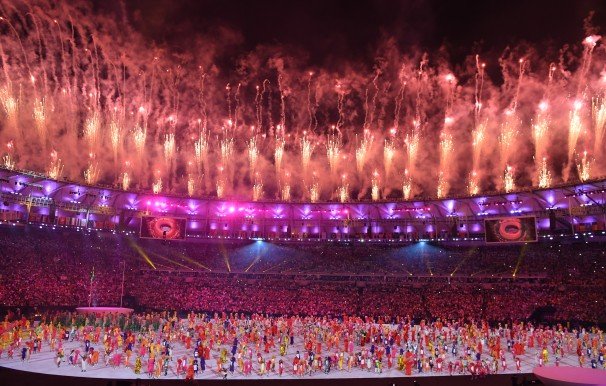
By Joseph Romanos and Michael Burgess
Peter Burling cut a proud figure when, clad in a traditional kakahu, or cloak, he led the New Zealand team into the colourful Maracana Stadium during the Olympic Games opening ceremony.
Burling was this week named co-captain of the New Zealand team, along with his sailing partner Blair Tuke, and was given the honour of being the flag-bearer. Departing Governor-General Sir Jerry Mateparae watched from the VIP seats with a beaming smile.
New Zealand entered after Norway, due to the Portuguese name spelling of Nova Zelanda. It made for quite a contrast, with New Zealand’s stern black uniforms against the Scandinavians, who appeared to be wearing 1980s style-ski jackets.
Burling and Tuke led an exuberant New Zealand team that was somewhat down on numbers because many athletes, including swimmers, rowers, hockey players and road cyclists, are competing so early in the Olympic programme.
Until 1988, this was not such a problem because the opening ceremony was held during the day time. Barcelona in 1992 was the first night opening ceremony. The precedent has been retained – the darkness adds to the atmosphere and enhances the innovative lighting, but it does mean many athletes can no longer justify marching because their performances would be affected.
The ceremony, in a packed stadium of 74,000, was typically Brazilian – colourful, vibrant and musical. It was possibly the first Olympic opening ceremony in which the spectators became participants. Instead of sitting and watching, the Brazilians contributed to the electric atmosphere by singing and dancing, even in the pre-show.
Brazilians don't need much encouragement on such occasions and during The Girl from Ipanema the whole stadium belted out the words, as they did during the following song, about the famous Rio Carnival.
Brazil is going through a serious recession and the budget for the opening ceremony was slashed until it was only 10 per cent of what was spent on the London 2012 opening ceremony. There were initially going to be 3000 performers, but the number was cut to 700.
It didn’t seem to inhibit the enjoyment of the occasion, with fireworks, acrobats, samba dancers, a supermodel and a 12-year-old rapper all featuring.
The story of Brazil was told, from indigenous tribes to the colonial era, slavery and modern skyscrapers.
The Olympics has the rare ability to bring nations together. Few who were there will forget the opening ceremony at Sydney in 2000, when North and South Korea marched as one team, as did Timor and East Timor.
There was a similar feeling at the Maracana Stadium when the Refugee Olympic team entered. Only half of the team of 10 marched, but they received the second-biggest cheer of the evening, after hosts Brazil.
The International Olympic Committee selected the 10 athletes from more than 40 candidates based on sports skill, refugee status, and personal background. The teammates come from four of the world's most troubled hotspots: Syria, South Sudan, Ethiopia and Democratic Republic of Congo. They marched in under the Olympic flag.
Other talking points from the ceremony:
Argentina are clearly still the grand rivals in this part of the world. When their team entered - the largest they have ever assembled - boos rang out, with earlier sentiments about celebrating and respecting differences forgotten.
The United States were by far the most popular team with other athletes - there was a rush to the front as the Americans passed from those seeking photos and selfies with some of the superstars of the Olympics, including team flag-bearer Michael Phelps.
Other teams to attract particular attention were troubled Palestine, who received massive applause, and a depleted Russian contingent. Many Russian competitors have been banned because of their country’s state-sponsored drugs regime, but those who marched were well received.
Spain won some big style points with their ensemble - including hats - and their dancing march into the stadium.
Teams were led into the stadium by models riding bikes. They were kept busy, leading out one team then rushing back to join the queue and quickly have the sign changed for their next assignment.
There was much curiosity among Brazilian fans about who would light the Olympic flame at the end of the ceremony. The choice would certainly have been footballer Pele, by far Brazil’s most internationally famous sports star, and Pele confirmed he had indeed been invited to perform the task. However, ill-health ruled out the 75-year-old.
Instead the flame was lit by Vanderlei Cordeiro de Lima, the man who was leading the 2008 Olympic marathon until he was tackled by an Irishman dressed as a priest. De Lima eventually finished third. He was later awarded the Pierre de Coubertein medal for sportsmanship.